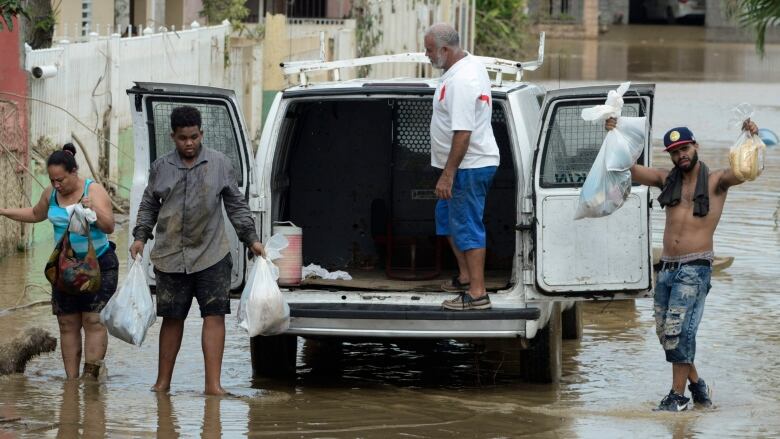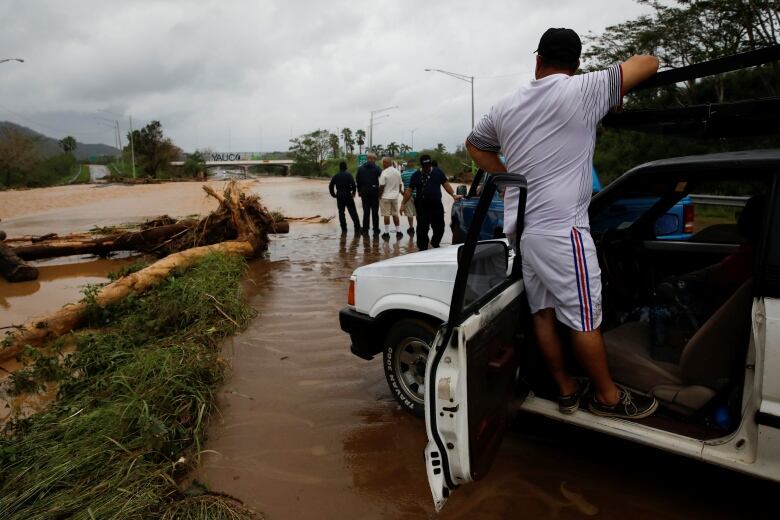Powerless Puerto Rico's storm crisis deepens with dam threatening to fail
With most cellphone towers and internet cables crippled, officials struggle to communicate with residents

Puerto Rican officials have beenunableto communicate with more than half the towns in the U.S. territory as they rush to evacuate tens of thousands of people downstream of a failing dam, and as the massive scale of the disaster wrought by Hurricane Maria startsto become clear.
- Stunned Puerto Rico seeks to rebuild after Hurricane Maria
- 'It's insane out here': Canadians desperate to help relatives stranded in Dominica
- Manitoba Dominican, Mexican communities reeling
Authorities launched an evacuation of the area downstream from the Guajataca Dam in northwest Puerto Rico, where 70,000 people live, sending buses to move people away Friday and posting frantic warnings on Twitter that went unseen by many in the blacked-out coastal area.
"This is an EXTREMELY DANGEROUS SITUATION," the U.S. National Weather Service wrote. "All the areas around the Guajataca River must evacuate NOW. Your lives are in DANGER."
Flash Flood Emergency for imminent dam break #LagoGuajataca continues. https://t.co/bSqMH5L7cE. If you live along #RioGuajataca? evacuate.
—@NWSSanJuanThe 316-metredam, which was built around 1928, holds back a human-made lake covering about five square kilometres. Nearly 40 centimetresof rain fell on the surrounding mountains after the Category 4 Hurricane Maria left the island Wednesday afternoon, swelling the reservoir behind the nearly 90-year-old dam.
An engineer inspecting the dam reported a "contained breach" that officials quickly realized was a crack that could be the first sign of total failure of the dam, U.S. National Weather Service meteorologist Anthony Reynes said.
'Really, really dire'
"There's no clue as to how long or how this can evolve. That is why the authorities are moving so fast because they also have the challenges of all the debris. It is a really, really dire situation," Reynes said.
Government spokesman Carlos Bermudez said that officials could not reach 40 of the 78 municipalities on the island more than two days after the hurricane crossed the territory, toppling power lines and cellphone towers and sending floodwaters cascading through city streets.
Officials said 1,360 of the island's 1,600 cellphone towers had been downed, and 85 per cent of above-ground and underground phone and internet cables were knocked out. With roads blocked and phones dead, officials said, the situation may be worse than they know.
"We haven't seen the extent of the damage," Gov. Ricardo Rossello told reporters in the capital. Rossello couldn't say when power might be restored.
Maj. Gen. Derek P. Rydholm, deputy to the chief of the U.S.Air Force Reserve, said at the Pentagon that it was impossible to say when communication and power would be restored. He said mobile communications systems are being flown in.
But Rydholm acknowledged "it's going to take a while" before people in Puerto Rico will be able to communicate with their families outside the island. Until Friday, he said, "there was no real understanding at all of the gravity of the situation."
Electricity grid already suffering
The island's electric grid was in sorry shape long before Maria struck. The territory's $73-billion debt crisis has left agencies like the state power company broke. It abandoned most basic maintenance in recent years, leaving the island subject to regular blackouts.
"Some transmission structures collapsed," Rossello said, adding that there was no severe damage to electric plants.
He said he was distributing 250 satellite phones from FEMA to mayors across the island to re-establish contact.

The death toll from Maria stood at six, but was likely to rise.
At least 27 lives in all have been lost around the Caribbean, including at least 15 on hard-hit Dominica. Haiti reported three deaths; Guadeloupe, two; and the Dominican Republic, one.
WestJet scheduled a flight Sunday to evacuate Canadians out of Dominica, the Canadian government announced Saturday.
#Dominica: Canadians wishing to purchase tickets go to https://t.co/IrEoA24Uy1 or present yourself at the airport. 2/3
—@TravelGoCCanadians in #Dominica: Bring valid Canadian travel documents. sos@international.gc.ca 3/3
—@TravelGoCAcross Puerto Rico, more than 15,000 people are in shelters, including some 2,000 rescued from the north coastal town of Toa Baja.
Some of the island's 3.4 million people planned to head to the U.S. to temporarily escape the devastation. At least in the short term, though, the soggy misery will continue: Additional rain up to 15 centimetres was expected through Saturday night.













_(720p).jpg)


 OFFICIAL HD MUSIC VIDEO.jpg)
.jpg)



























































































